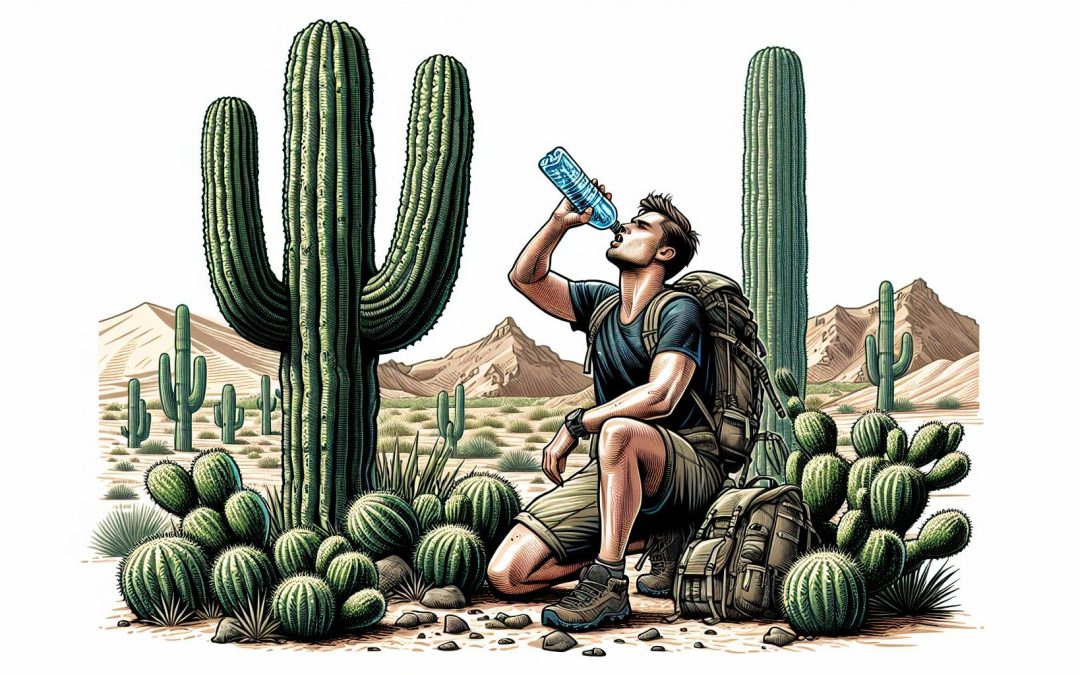Ah, Scottsdale! With its sun-soaked days and breathtaking desert landscapes, it’s a paradise for outdoor enthusiasts and sun-seekers alike. But let’s not forget, navigating the dry, desert climate can be a bit of a challenge, especially when it comes to staying hydrated.
Understanding the Desert Climate of Scottsdale
When I first planned my trip to Scottsdale, I knew I was heading into a desert climate. But it’s one thing to know and another to experience. The desert climate of Scottsdale is characterized by low humidity, high temperatures, and lots of sunshine. Summer temperatures often soar above 100°F, while winter offers a milder reprieve with averages around 70°F. This wide range of temperatures combined with low humidity levels means that staying hydrated becomes a bit more challenging than in more temperate climates.
I learned early on that the dry air could deceive me into thinking I wasn’t sweating, when in fact, my body was losing moisture rapidly. This is a crucial point for anyone spending time outdoors in Scottsdale. The sunshine might entice you to stay out longer, but it’s important to recognize the signs of dehydration before they become problematic. Common symptoms include thirst, dry skin, fatigue, and light-headedness.
To prepare, I always check the weather forecast before planning my day. This simple step helps me anticipate the hydration needs based on the expected temperatures. During the hotter months, I plan outdoor activities either in the early morning or late afternoon, avoiding the peak sun hours.
Equally important is understanding the effects of the desert climate on hydration strategies. In Scottsdale, I quickly realized that just drinking water wasn’t enough. I needed to replenish electrolytes lost through sweat. So, I started including sports drinks and snacks high in electrolytes, like bananas and nuts, in my hydration plan.
Adapting to the desert climate in Scottsdale has been an interesting journey of learning and preparation. Staying hydrated requires a bit more effort here, but with the right strategies, it’s entirely manageable. Whether hiking through the beautiful desert landscape or exploring the vibrant city, keeping the unique challenges of this climate in mind has helped me enjoy all that Scottsdale has to offer without succumbing to dehydration.
Importance of Hydration in Desert Environments

Staying hydrated isn’t just a matter of drinking water, especially in a desert like Scottsdale. It’s about understanding how your body responds to extreme conditions. I’ve learned that the dry air rapidly steals moisture not just from my skin but from my breathing as well. This insidious dehydration can catch you off guard because you might not realize how much fluid you’re losing.
In desert climates, your sweat evaporates faster than you’re used to, tricking you into thinking you’re not losing water as quickly as you are. This means you’re not just battling the heat; you’re fighting your own senses. For me, recognizing this was a game-changer. By monitoring my water intake and not relying solely on thirst as an indicator, I’ve managed to stay ahead of dehydration.
But it’s not just about water. I’ve learned that electrolyte balance is crucial. The right mix of sodium, potassium, and magnesium is vital for keeping your body functions running smoothly. Without it, no matter how much water I drink, I still end up feeling sluggish and sometimes even get cramps.
One approach I’ve taken is to include sports drinks and various hydrating snacks in my routine. Fruits like watermelon and cucumber are not only refreshing but provide that essential nutrient boost. It’s a tasty and effective way to maintain hydration and enjoy what Scottsdale has to offer.
Remember, dehydration can escalate quickly in the desert, leading to serious complications like heat stroke. I always make sure to carry more water than I think I’ll need. It’s surprising how a simple precaution can significantly impact my outdoor experiences, making them safer and more enjoyable.
In my adventures through Scottsdale, planning has been key. Whether I’m hiking up the McDowell Sonoran Preserve at dawn or exploring Old Town’s charm, my hydration strategy is as important as my itinerary. Keeping an eye on the weather forecasts and adjusting my fluid intake accordingly has become second nature.
Recommended Fluid Intake Levels for Scottsdale’s Climate
In Scottsdale’s arid climate, staying on top of hydration requires more than just sipping water now and then. It’s about understanding and applying recommended fluid intake levels specific to this desert environment. I’ve learned through experience and advice from health experts that the usual “eight glasses a day” doesn’t quite cut it here.
The National Academies of Sciences, Engineering, and Medicine suggests a daily fluid intake of about 3.7 liters (125 ounces) for men and 2.7 liters (91 ounces) for women. However, Scottsdale’s Desert Climate demands an adjustment to these guidelines. Considering the high temperatures and low humidity, I typically aim for an additional 20-30% on top of these recommendations. That means I’m drinking at least 4 to 4.5 liters of fluids if I’m a man, and 3 to 3.2 liters if I’m a woman, especially on days I spend significant time outdoors.
| Gender | Standard Daily Intake | Adjusted Intake for Scottsdale |
|---|---|---|
| Men | 3.7 liters (125 ounces) | 4.4-4.6 liters (149-155 ounces) |
| Women | 2.7 liters (91 ounces) | 3.2-3.4 liters (108-115 ounces) |
Keep in mind, about 20% of our fluid intake comes from food. In a desert climate, I make it a point to include hydrating foods in my diet. Foods like cucumbers, watermelon, and oranges not only provide essential nutrients but also contribute to my overall fluid intake.
Monitoring urine color can serve as a handy hydration barometer. I aim for pale, straw-colored urine as an indicator that I’m well-hydrated. Darker urine suggests I need to increase my fluid intake.
Adopting these hydration strategies has significantly improved my ability to enjoy Scottsdale without the looming threat of dehydration. I focus on balancing water, electrolyte drinks, and hydrating foods, ensuring I’m prepared for whatever the desert climate throws my way.
Hydration Tips for Outdoor Activities in Scottsdale
When it comes to enjoying the great outdoors in Scottsdale, I’ve found that staying hydrated is key to making the most of your adventures. Given the city’s desert climate, outdoor activities can quickly lead to dehydration if you’re not careful. Here are some hydration tips I’ve picked up over the years that have helped me stay hydrated and healthy while exploring Scottsdale.
First and foremost, I always start my day with a large glass of water before heading out. This pre-hydration strategy is crucial because it sets a positive tone for the rest of the day. Additionally, I make it a point to carry a reusable water bottle with me at all times. Not only is this environmentally friendly, but it also serves as a constant reminder to take sips throughout the day, even if I’m not feeling particularly thirsty.
It’s also important to dress appropriately for the weather. Lightweight, breathable clothing can help minimize sweating, thus conserving body moisture. I opt for light colors that reflect rather than absorb the sun’s rays. Wearing a wide-brimmed hat and sunglasses can further protect against the sun and reduce the risk of heat-related dehydration.
Hydration Pack Essentials when planning longer hikes or outdoor excursions in Scottsdale include:
- Electrolyte replacements: These are vital for replenishing salts lost through sweat.
- Snacks high in water content: Think fruits like oranges or apples, which can help with hydration.
- Extra water: It’s always better to carry more than you think you’ll need.
Monitoring my fluid intake is something I’ve learned to do routinely. I aim for at least one 8-ounce glass of water every hour, and more if I’m engaged in strenuous activities. This might seem like a lot, but in Scottsdale’s dry heat, it’s easy to lose fluids quickly without realizing it.
Remembering to eat regularly while staying hydrated is another piece of advice that’s served me well. Foods high in water content, such as watermelon, strawberries, and cucumbers, are not only refreshing but they also contribute to your overall fluid intake.
Incorporating these hydration tips into your outdoor activity planning in Scottsdale can significantly enhance your experience. Staying properly hydrated ensures that you have the energy to explore and enjoy all the natural beauty and adventure that Scottsdale has to offer.
Dealing with Dehydration Warning Signs

Recognizing the warning signs of dehydration is critical, especially in the desert climate of Scottsdale where the body loses water more rapidly than usual. I’ve learned from experience that being proactive about hydration can save the day, and identifying these signs early on makes all the difference. So, let’s dive into the important indicators to watch out for and how to address them.
First and foremost, feeling thirsty is the body’s initial signal that it’s time to replenish fluids. It might seem obvious, but it’s easy to ignore thirst when you’re engrossed in outdoor activities. Another tell-tale sign is dry mouth or chapped lips, a clear indication that my body’s crying out for water. Dark urine is also a red flag; it means my body is conserving water, and I need to increase my intake immediately.
When I’m out exploring the beauty of Scottsdale’s natural terrain, I keep an eye out for more severe symptoms of dehydration, such as dizziness, fatigue, and confusion. These symptoms mean dehydration is advancing, and it’s time to take action fast. Here’s what I do:
- Stop all activity and seek shade. It’s crucial to rest and protect myself from the sun.
- Sip water slowly. Gulping it down can lead to stomach cramps, so I take it slow.
- Cool my body. I use a wet cloth on my neck and forehead to help lower my body temperature.
And here’s a pro tip: Always have an electrolyte solution on hand. Electrolytes are vital for hydration and can help me recover faster. I always pack a sports drink or electrolyte tablets, especially for longer hikes or outdoor activities.
| Dehydration Sign | Action Step |
|---|---|
| Thirst and Dry Mouth | Drink water slowly |
| Dark Urine | Increase water intake |
| Dizziness and Fatigue | Rest in the shade, drink electrolytes |
By being vigilant and prepared, I ensure my outdoor adventures in Scottsdale are not only enjoyable but also safe. Remember, it’s always better to prevent dehydration than to treat it, so keep that water bottle handy and listen to what your body’s telling you.
Conclusion
Staying hydrated in Scottsdale’s desert climate isn’t just about quenching your thirst—it’s about keeping your adventures safe and enjoyable. By tuning into your body’s signals and taking action before dehydration sets in, you’re setting yourself up for a great time outdoors. Remember, it’s all about being prepared and attentive. So grab that water bottle, pack some electrolytes, and let’s make every outdoor adventure in Scottsdale a fantastic one. Stay hydrated, my friends!







